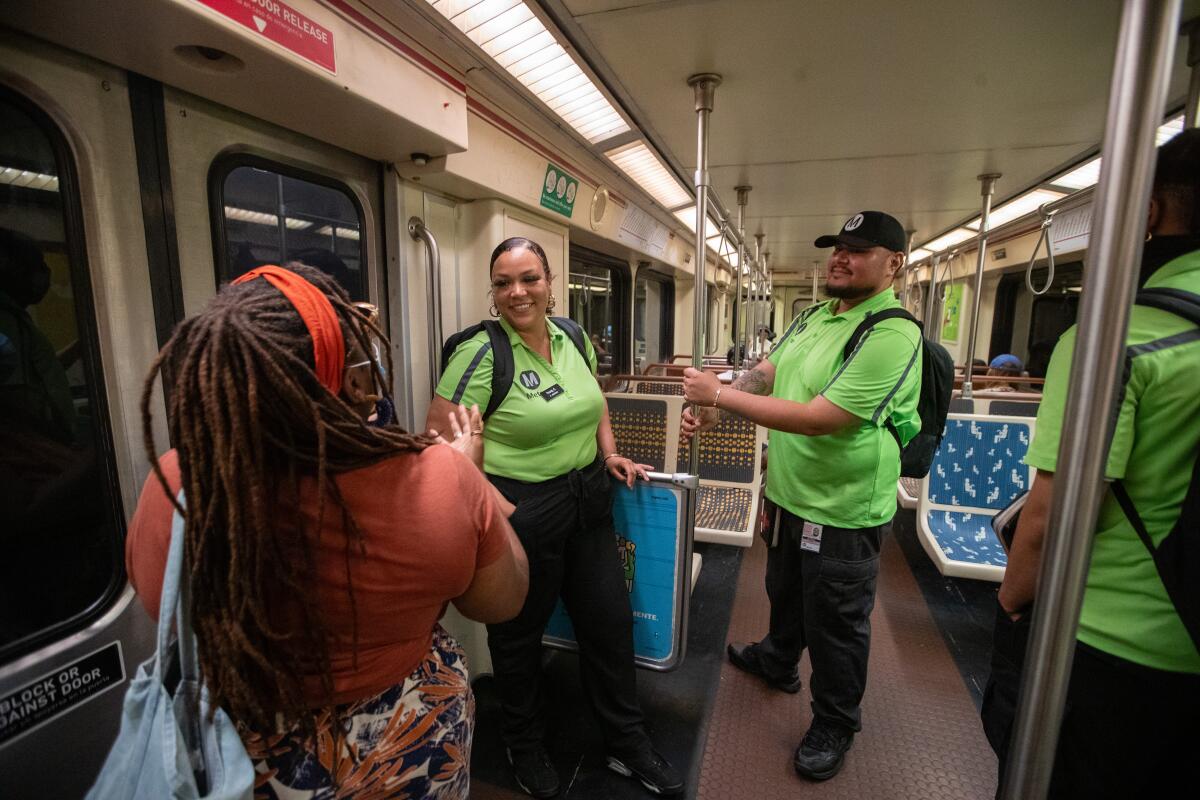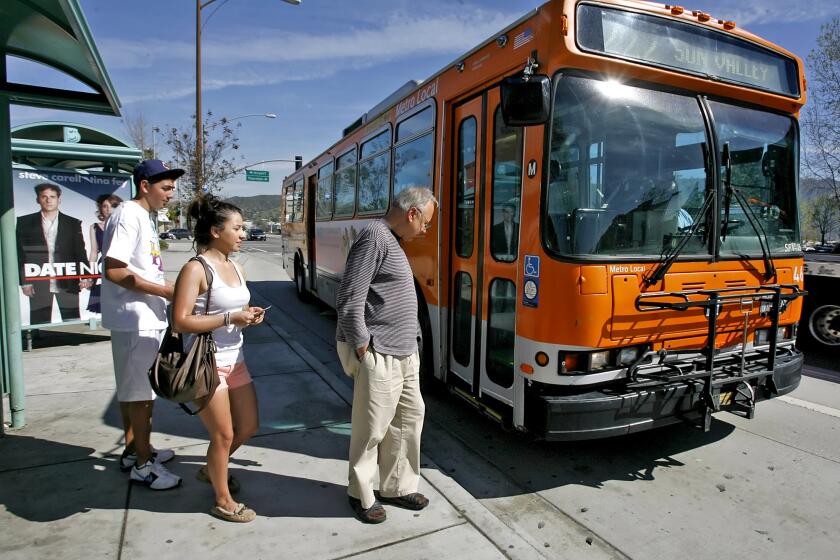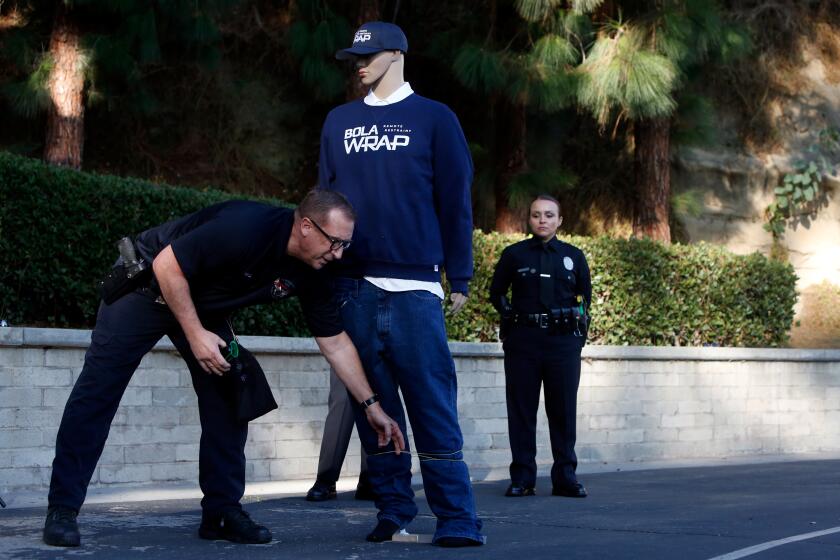Metro wants riders back. Those green-shirted ‘transit ambassadors’ are part of the plan

- Share via
Aiming to bring Angelenos back to a public transportation system that has struggled with safety concerns and declining ridership, Metro officials say they have a success story with so-called transit ambassadors, who have spent the last year riding trains and buses in bright green shirts to offer a helping hand.
Metro’s public safety committee voted unanimously Thursday for the ambassador pilot program to become a permanent part of the transit system. The full Los Angeles County Metropolitan Transportation Authority board of directors will vote on the proposal Oct. 26.
Since Metro launched the pilot program in September 2022, about 350 transit ambassadors have had more than 500,000 interactions with riders, according to a staff report presented to a Metro committee Thursday.
The unarmed ambassadors ride the transit system and help riders on train platforms or Metro hubs, pointing them in the right direction during major disruptions or helping elderly people navigate when an escalator is broken. They do not issue citations, but they report problems to law enforcement and document vandalism or other crimes.
In its first survey since 2019, the Los Angeles Metropolitan Transportation Authority found safety, timeliness are main concerns for bus and rail riders.
Los Angeles County Supervisor Holly Mitchell, who chairs Metro’s Operations, Safety and Customer Experience Committee, championed the program’s success. At the committee meeting Thursday, she said the ambassadors not only provide operational help to riders but are also a means to make public transportation more personal.
“They’re the human touch,” Mitchell said. “They are also the ambassadors of our culture, of how we want to be perceived as a transit agency and how we want people to experience riding public transit. I am glad that the statistics are bearing the fruit that we anticipated and hoped for.”
Over the last six months, ambassadors used naloxone to reverse 52 opioid overdoses, Metro said. During that same time period, ambassadors helped 20 people by performing CPR, intervening during a suicide attempt and other events, according to the staff report.
One of the most critical roles the ambassadors play, chief customer experience officer Jennifer Vides said, is making riders feel safer.
Last year, a survey of more than 12,000 bus and train riders showed a decline in ridership among women compared with 2019 ridership numbers. Women made up 53% of bus riders pre-pandemic, and just 49% in 2022. Women were more likely to cite safety as the top issue on which they wanted Metro to make improvements.
Recent attempts to increase safety on the transit system included a proposal by the Los Angeles Police Department to arm officers with lasso-like weapons to subdue citizens, but the Metro board said that plan was premature. Metro’s own attempts have focused on the ambassador program and other measures.
Metro announced Thursday that ridership jumped 10% over the last year, marking a steady increase over the previous 10 months, climbing back to nearly 80% of its 2019 pre-pandemic level.
In a recent rider survey, 63% of people polled felt ambassadors made their ride on a Metro train feel safer; among low income communities, women and people of color, that rate was even higher. And 61% of those surveyed said they would want to see more ambassadors on Metro.
Some riders surveyed said they were unclear on what the ambassadors could do, and others were unsure why ambassadors often appeared to be looking down at their phones on the job. That doesn’t mean they’re distracted — using the phone is part of reporting necessary maintenance and other services needed, Vides said.
A proposal to arm LAPD officers patrolling trains and buses with the BolaWrap, a nonlethal device meant to bind a person with a quick-deploy cord, is now on hold.
If the ambassadors were a permanent part of Metro, they would receive better employee benefits, according to the staff report. Retention, administration, training and collaboration among other Metro departments would improve, according to the staff report.
Los Angeles City Councilman and Metro board member Paul Krekorian asked if the Metro staff looked into any alternatives to bringing the program in-house. If approved by the full board, the ambassador program could stay under its $20 million annual budget, according to Metro staff.
“Instinctively, I feel like it would be better, just because of command and control and efficiency,” Krekorian said at Thursday’s meeting. “This is a big program. This is a big, very expensive program that we’re making it permanent after a trial period.”
The initial goal was to start the program as a pilot, outsource it and then bring it in-house if it proved successful, Metro CEO Stephanie Wiggins said. Currently, the program is managed by third-party vendors.
There’s also concern about a high turnover rate among those employees compared with others in the Metro transit system, Wiggins said.
The ambassador program was first proposed as L.A. County reevaluated its approach to public safety and how Black and brown riders felt when approached by law enforcement. Integrating the program into Metro would signal to the police agencies that patrol the trains and buses that the ambassadors are not just a temporary strategy but part of a “reimagined public safety network,” Wiggins said.
More to Read
Sign up for Essential California
The most important California stories and recommendations in your inbox every morning.
You may occasionally receive promotional content from the Los Angeles Times.













